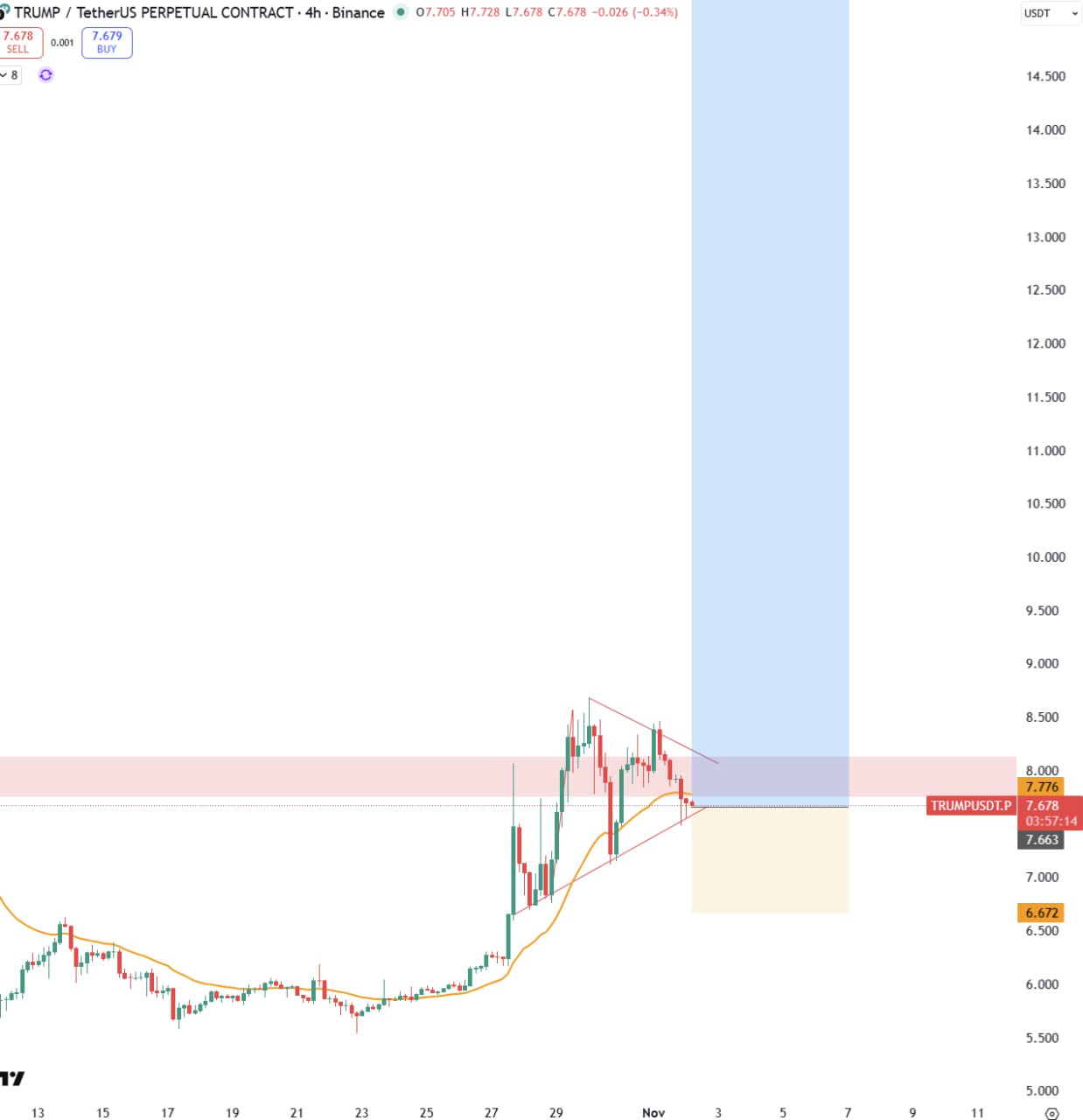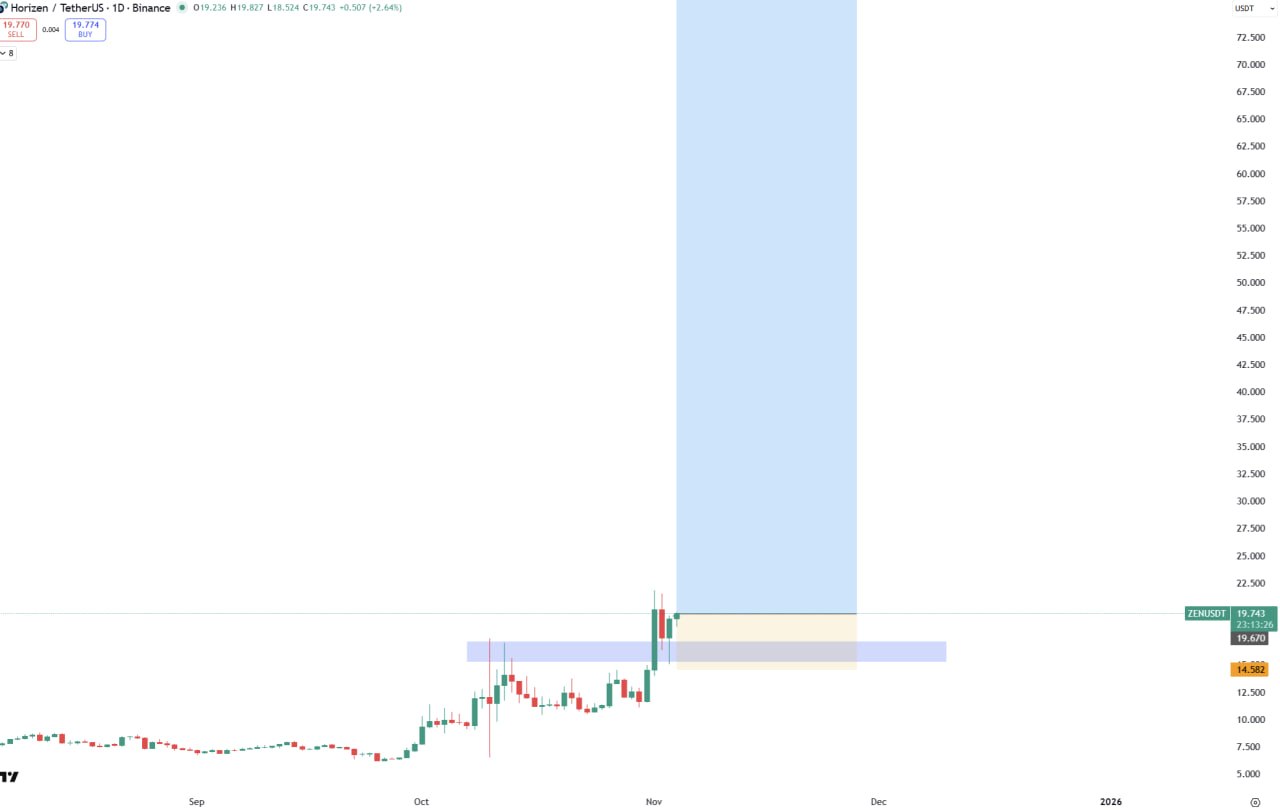TRUMP/USDT.P — Long
2025-10-31 23:05
Long TRUMP at 7.7 with targets 8.5 | 9.2 | 11.6 and hard invalidation 6.672.

If the TradingView symbol is unavailable, use the annotated image as reference for target zones & invalidation.
TRUMP/USDT.P Long Trade Signal — October 31, 2025
This strategy targets a long in TRUMP near 7.7, with stair-stepped take-profits at 8.5, 9.2, and 11.6, guarded by a hard stop at 6.672. Regardless of the token’s branding or social resonance, we treat it as an instrument with observable structure and trade it with the same rigor as any other: identify a base, confirm acceptance above reclaimed supply, monetize the first push, then trail only if the market proves it deserves more room.
Market Context
Socially charged tickers often behave like leverage on attention. That can be a gift or a trap. The gift: when participation swells, liquidity improves and moves extend. The trap: when attention swings away, reversions are brutal. To navigate this, we anchor in structure and ignore the noise. Across the alt complex, dispersion is high—some names rally hard while others slog. TRUMP has recently transitioned from reactive selling to proactive bidding around support zones, a tell that inventories have rotated to stronger hands.
Another contextual factor: venue mechanics. Perps with active retail bases can exhibit positive feedback loops where funding spikes into resistance, forcing weak longs to exit and providing better entries later. Conversely, balanced or mildly positive funding during breakouts tends to be healthier. Our plan incorporates those cues: we prefer to add only after clean retests, not into euphoric candles where funding and open interest balloon simultaneously.
Technical Analysis
Structure: TRUMP has built a multi-session base between ~6.9 and ~7.5, then broke and accepted above 7.6–7.7. Each dip into the upper half of the base has been absorbed, leaving consecutive higher lows on 1H/4H. Resistance clusters align with our targets: 8.5 (local shelf and round number), 9.2 (supply pocket), and 11.6 (prior pivot/psychological magnet).
- Trend: Uptrend attempting to reassert on 4H; daily trend flattening after a corrective phase.
- Momentum: Momentum readings have improved, with clean pushes followed by shallow, time-based consolidations.
- Volume: Turnover expanded on breakouts and cooled during rests—a good sign. Watch that this pattern persists.
- Liquidity: Spreads are acceptable during liquid hours; widen materially in off-hours. Plan entries accordingly.
Key Levels
- Entry: 7.7 (tolerance 7.66–7.74)
- Targets: 8.5 → 9.2 → 11.6
- Stoploss: 6.672 (beneath base failure zone; daily close below implies invalidation)
- Support: 7.45–7.55 (retest shelf), 7.10–7.20 (secondary), 6.80–6.90 (deep support)
- Resistance: 8.40–8.60, 9.10–9.30, 11.2–11.8
Execution Map
- Enter on a pullback that respects 7.6–7.7 with a 1H close back above 7.7 to confirm acceptance.
- Take first profits at 8.5 to derisk; if 8.5 becomes support on a closing basis, advance the stop below the most recent 1H higher low.
- Scale another partial at 9.2. If momentum remains and funding stays balanced, trail a runner toward 11.6 using a structure stop on the 1H/4H.
- Into 11.6, either finalize the exit or maintain a minimal runner only if the tape is one-way (thinning offers, strong breadth, expanding volume).
Failure Signals
A fast rejection from 8.5 with negative delta and rising open interest (fresh shorts) is a caution; failure to hold 7.6 on closes after two attempts suggests base failure—reduce exposure or exit. A daily close below 7.10 would reset the chart entirely.
Risk Management
Volatility is the point of the trade; risk control is the profit engine. Keep size appropriate to the distance between entry and stop. Use the hard stop at 6.672 without negotiation. After the first target pays, protect progress: either trail under structure or, if structure is noisy, lock partial gains and let only a modest runner express upside.
- Respect a max daily drawdown. If you hit it, stop trading for the day.
- Use limit orders at levels to manage slippage; avoid chasing green candles.
- Do not add into resistance or when funding spikes into euphoria; wait for retests.
- Keep leverage moderate; liquidation levels should be far from your hard stop.
This is educational material, not financial advice. Trading derivatives is risky and can lead to losses. You are responsible for risk, sizing, and execution.








